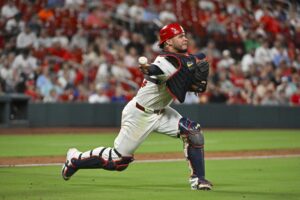Diamondbacks Starting Pitching Has Work to Do
The Arizona Diamondbacks had Thursday off to head from Denver back home to Phoenix. On Friday they will open a five-game homestand, with three against the division-rival San Diego Padres and two against the AL West-leading Oakland Athletics. They currently sit in fourth place with an 8-11 record, four and a half games behind the division-leading Colorado Rockies. Part of the reason for their disappointing record so far has been a lack of offensive production, but their biggest problem lies in their starting pitching.
Two of the five starters – Zac Gallen and Merrill Kelly – have been brilliant, but the other three have struggled mightily. Madison Bumgarner – a marquee free agent signing who started the season as the ace – looked so-so in his first start but has been lit up since. He went on the injured list Monday with a mid-back strain. Robbie Ray has been rocked in every start thus far, and Luke Weaver has in all but the most recent one.
Diamondbacks Starting Pitching Woes Run Deep
There are several reasons for their struggles. Their collective WHIP – 1.522 – is higher than the league average of 1.290. The difference translates into allowing nearly one more baserunner every three innings. They allow nearly two more hits per nine innings (10.1) than the league average (8.3). While their walks per nine (3.6) is moderately higher than the league average (3.0), their home runs per nine rate of 2.9 is significantly higher than the league average of 1.5.
Another telling statistic is Game Score. Bill James invented this statistic to give a general idea of how well a pitcher’s start goes. Each pitcher starts with 50 points. For each out recorded, he gets a point, meaning three points per inning pitch. He gets two points for every completed inning after the fourth and gets one point for each strikeout. As far as deductions go, he loses two points for each hit allowed, four points for each earned run allowed, two points for each unearned run, and one point for each walk. The only two starters with Game Score averages above 50 are – you guessed it – Gallen and Kelly. Bumgarner’s high is 56, but his low is also 19, and his average is 37.0. Ray and Weaver posted maxes of 45 and 49, respectively, and averages of 34.5 and 33.7, respectively.
Earned Runs Galore
It should come as no surprise that their combined ERA is 6.75 – over two runs higher than the league average of 4.51. That translates to an ERA-minus (park-adjusted ERA divided by league ERA, multiplied by 100) of 147 – 47% higher than the league average.
When looking at individuals, it further illustrates that Gallen and Kelly have combined to save the rotation from total disaster. Bumgarner has an ERA of 9.35, which is an ERA-minus (ERA-) of 203. Ray’s ERA is 10.59 (230 ERA-), while Weaver’s is 11.85 (258 ERA-). Gallen’s ERA, by contrast is 2.74. This gives him an ERA- of 60, which is currently 18th amongst all National League starters. Kelly’s is even more impressive – 2.29, giving him an ERA- of 50 – 10th-best amongst all NL starters.
Diamondbacks Pitching Percentages
Not surprisingly, avoiding the long ball has helped both Gallen and Kelly. Their home run percentages – the percentage of plate appearances resulting in a home run – are 4.3% and 5.3%. Bumgarner and Ray are 8.4% and 8.1%, respectively, while Weaver is 10.0%. The glaring difference also exists when comparing extra-base hits. Only 6.4% of plate appearances with Gallen on the mound resulted in an extra-base hit. With Kelly, it’s 9.2%. With the other three – Bumgarner, Ray, and Weaver – it’s 12.1%, 13.8%, and 17.1%, respectively. Furthermore, half or more of all hits off those three have gone for extra bases: 50% for Bumgarner and 55% for both Ray and Weaver.
Walks have also hurt. Gallen (7.5%), Kelly (1.3%), and Bumgarner (8.4%) have kept their walk percentages low, but the other two have struggled. In a season where the league average so far is 8.9%, Weaver has walked 10% of the batters he’s faced, and Ray has done so with 16.1%. One look at their first-pitch strike percentages shows a huge reason why. Weaver has thrown a strike on the first pitch 54.9% of the time, while Ray has done so 41.4% of the time. Everyone else on the staff has done it more than 60% of the time. For reference, 60% is the league average.
Double plays are a pitcher’s best friend. Gallen and Kelly each have pitched in 10 double play opportunities. Gallen produced a double play grounder twice, and Kelly did three times – 20% and 30%, respectively. The other three pitchers combined have produced one double play grounder in 50 opportunities – Bumgarner, who had 19 chances (5%). Ray has 0 in 12 chances, while Weaver has 0 in 19 chances.
Outlook
Diamondbacks pitching coach Matt Herges told the press in early August that one of his mottos is to “win the first three pitches.” Ray and Weaver have struggled mightily in this department, leading to alarmingly high numbers in WHIP and walks per nine. Both have a WHIP over 2.000 – 2.118 for Ray and 2.122 for Weaver. Ray’s walks per nine ratio is 7.4, and Weaver’s is 4.6. Contrast that with Kelly, who has a WHIP of 0.966 – 10th in the National League – and an NL-best BB/9 ratio of 0.5. (Specifically, it’s 0.458.)
It is great that Gallen and Kelly are doing as well as they are. However, for the Diamondbacks to move toward the top of the NL West standings, the rest of the staff must follow suit. Hopefully Bumgarner’s rough start came because of his back injury. If he can return to the form that landed him the huge contract in the offseason, that will be a key step in the right direction. Ray and Weaver need to keep their walks down and keep the ball in the ballpark. Walks and home runs are not a good combo for pitching – especially when walks precede the home run. If they don’t, then this might end up being one of the most disappointing Diamondbacks seasons in a long time.
All data compiled by author from Baseball Reference and Fangraphs.
Main Photo
Embed from Getty Images






